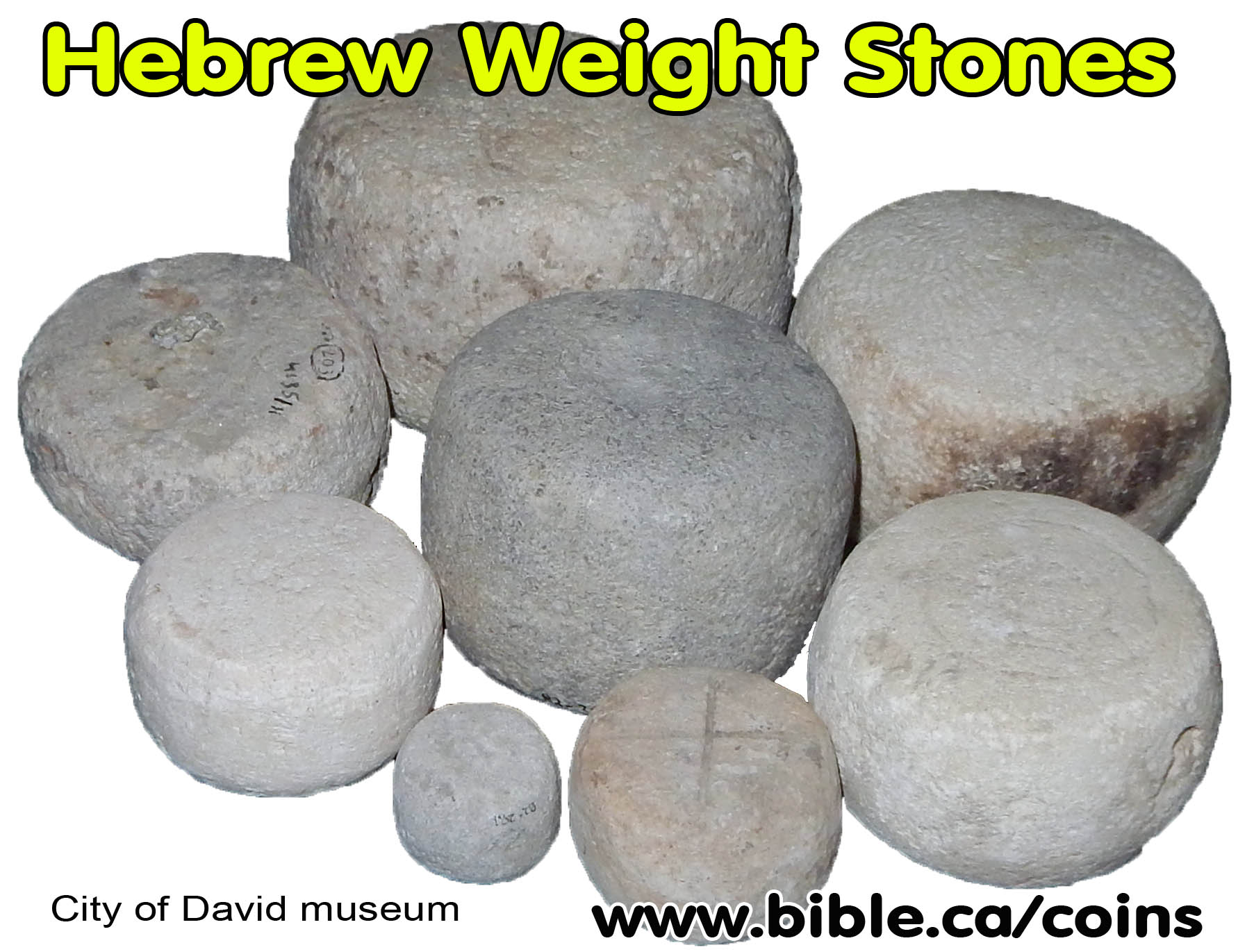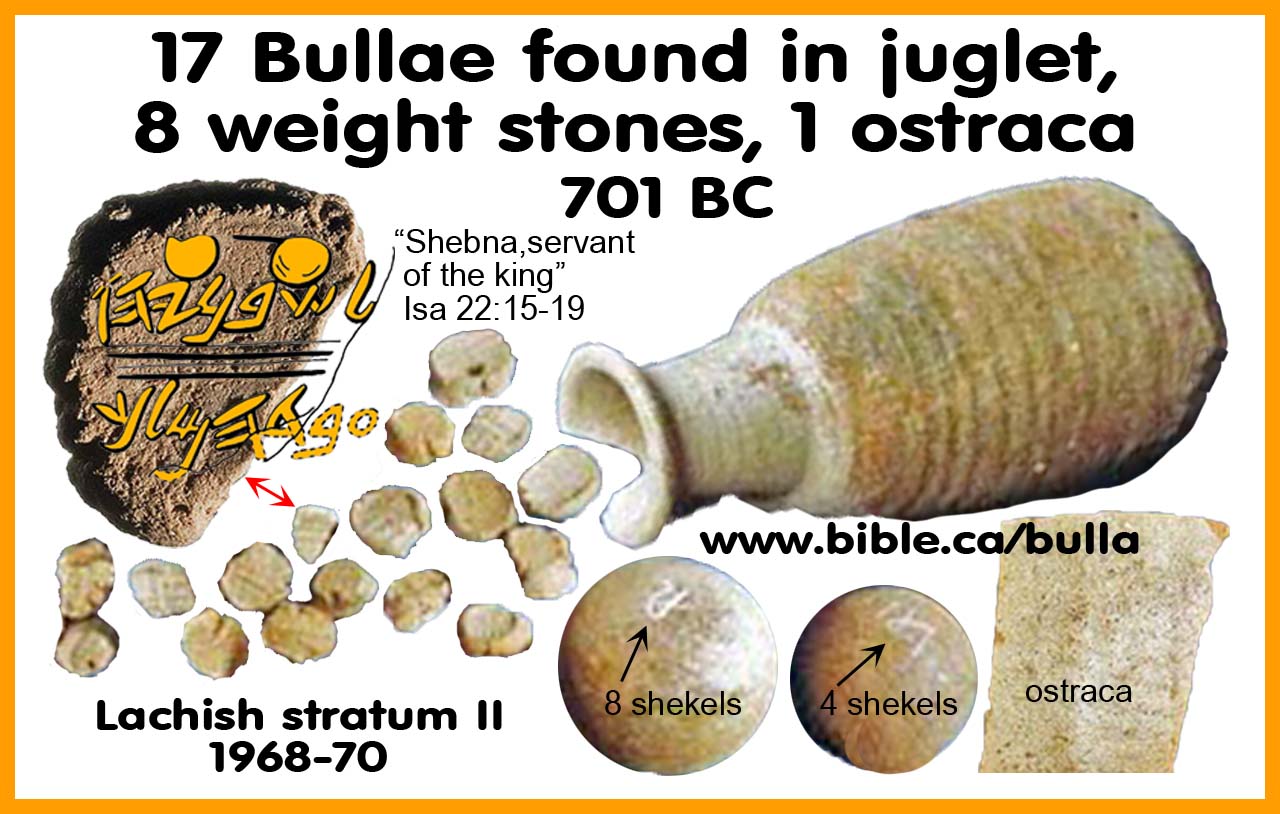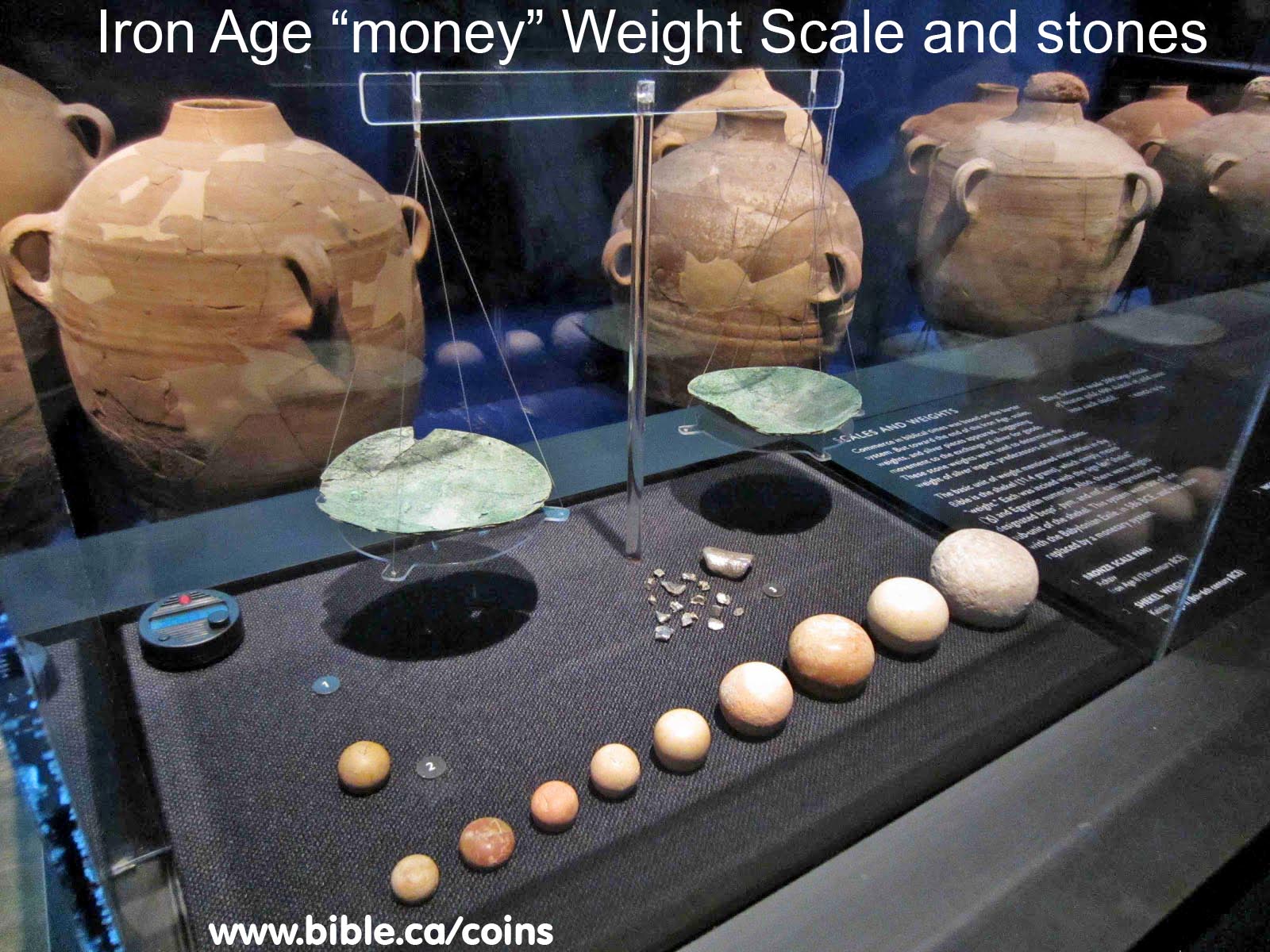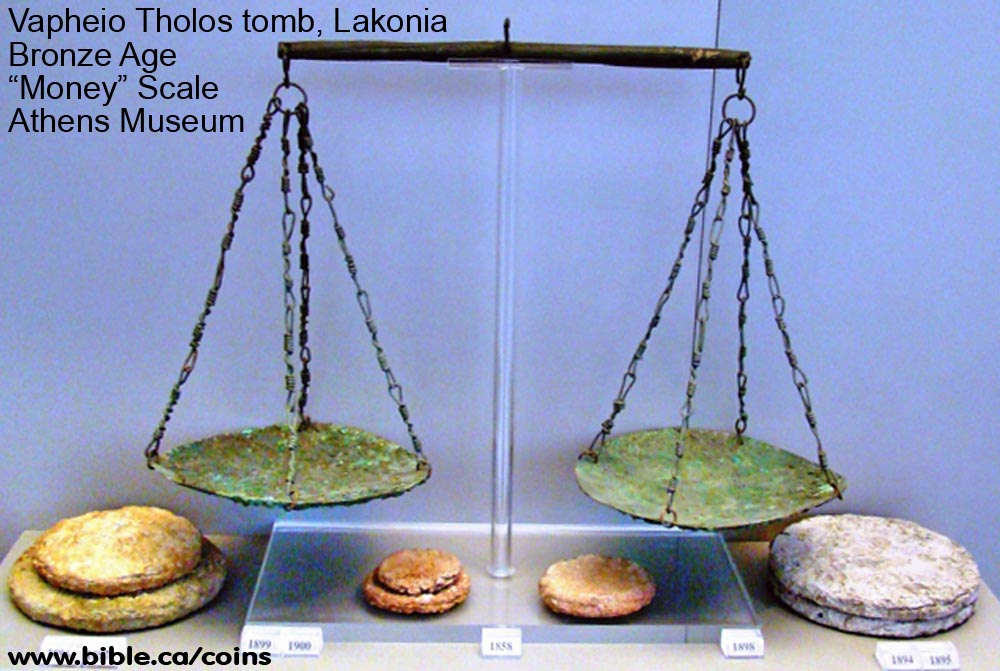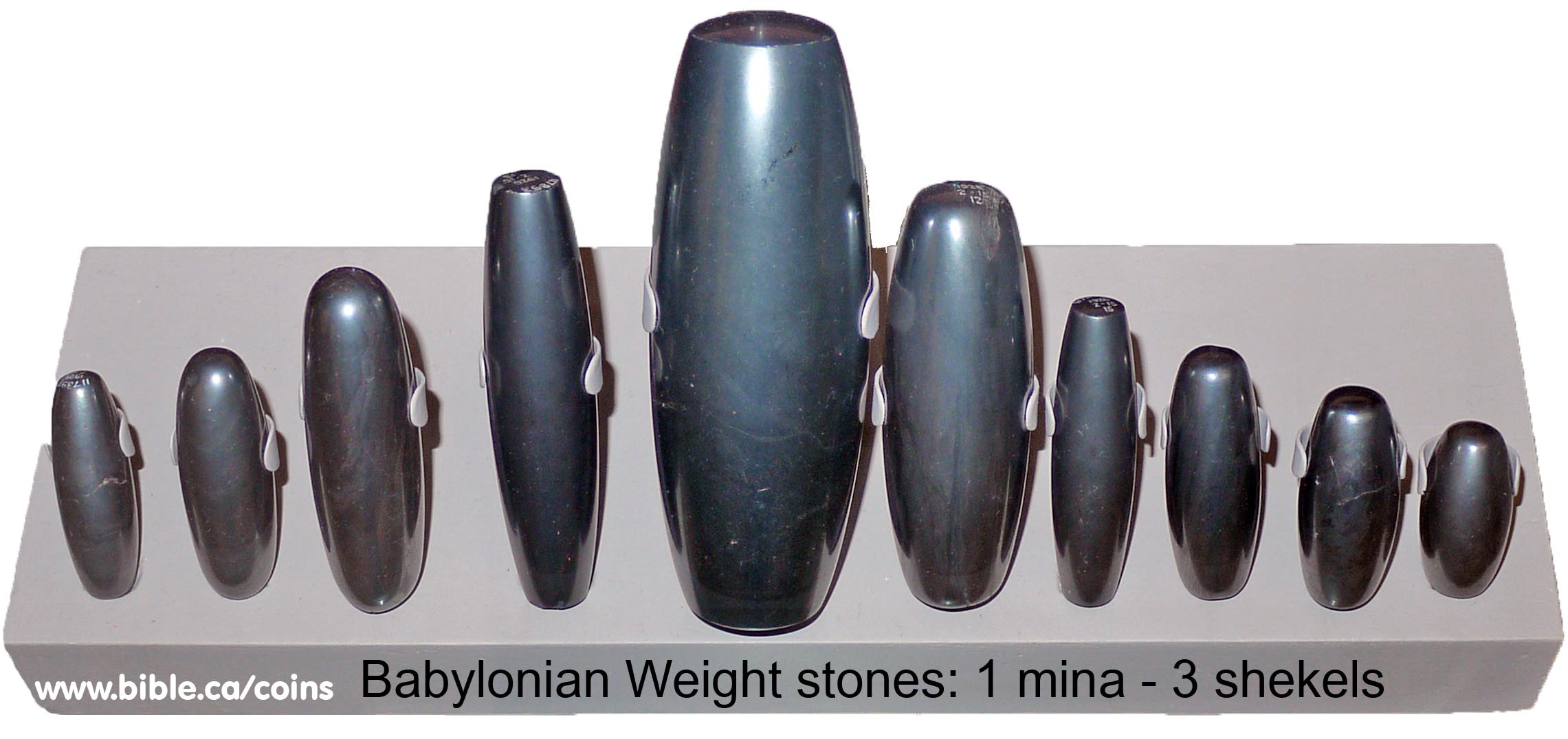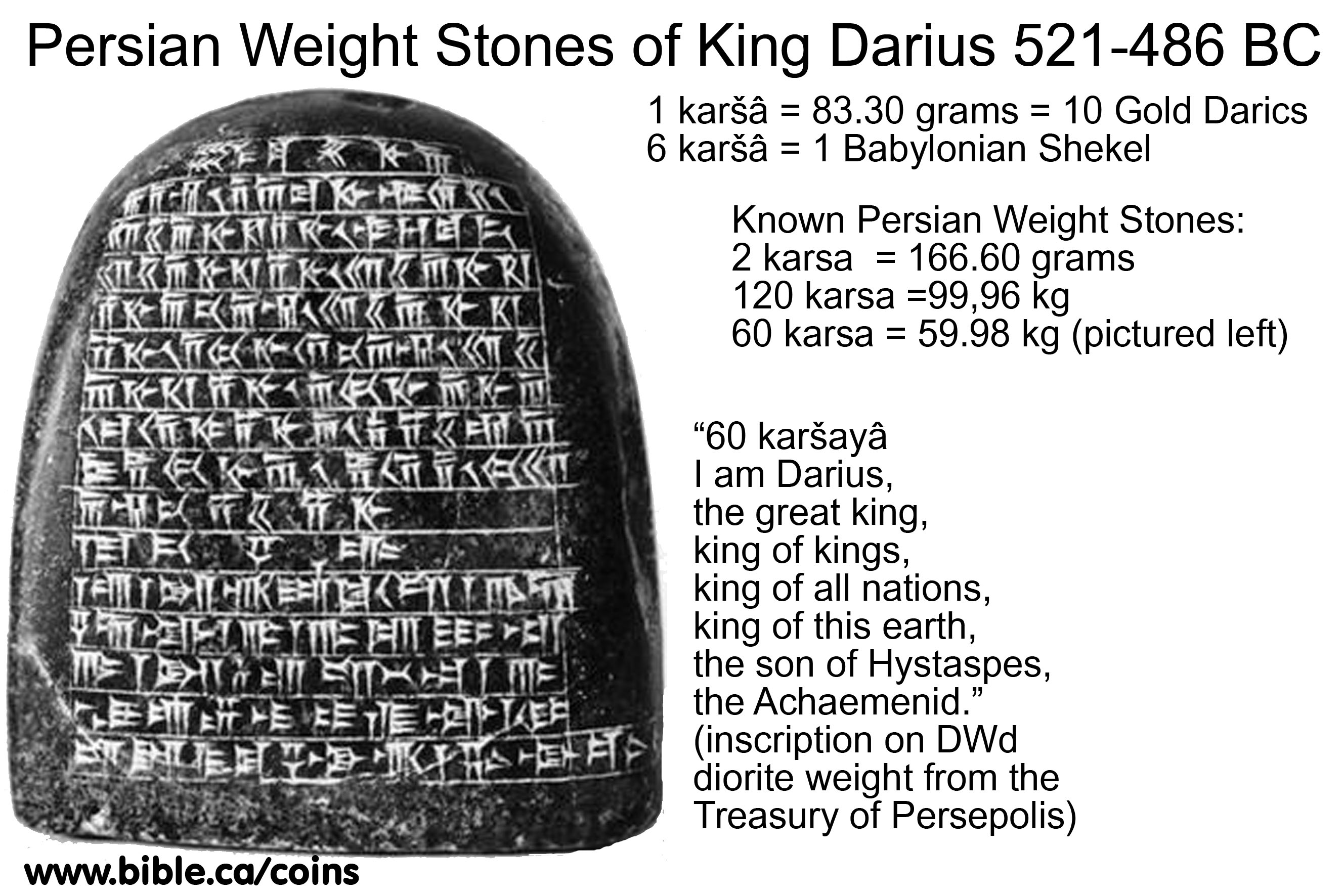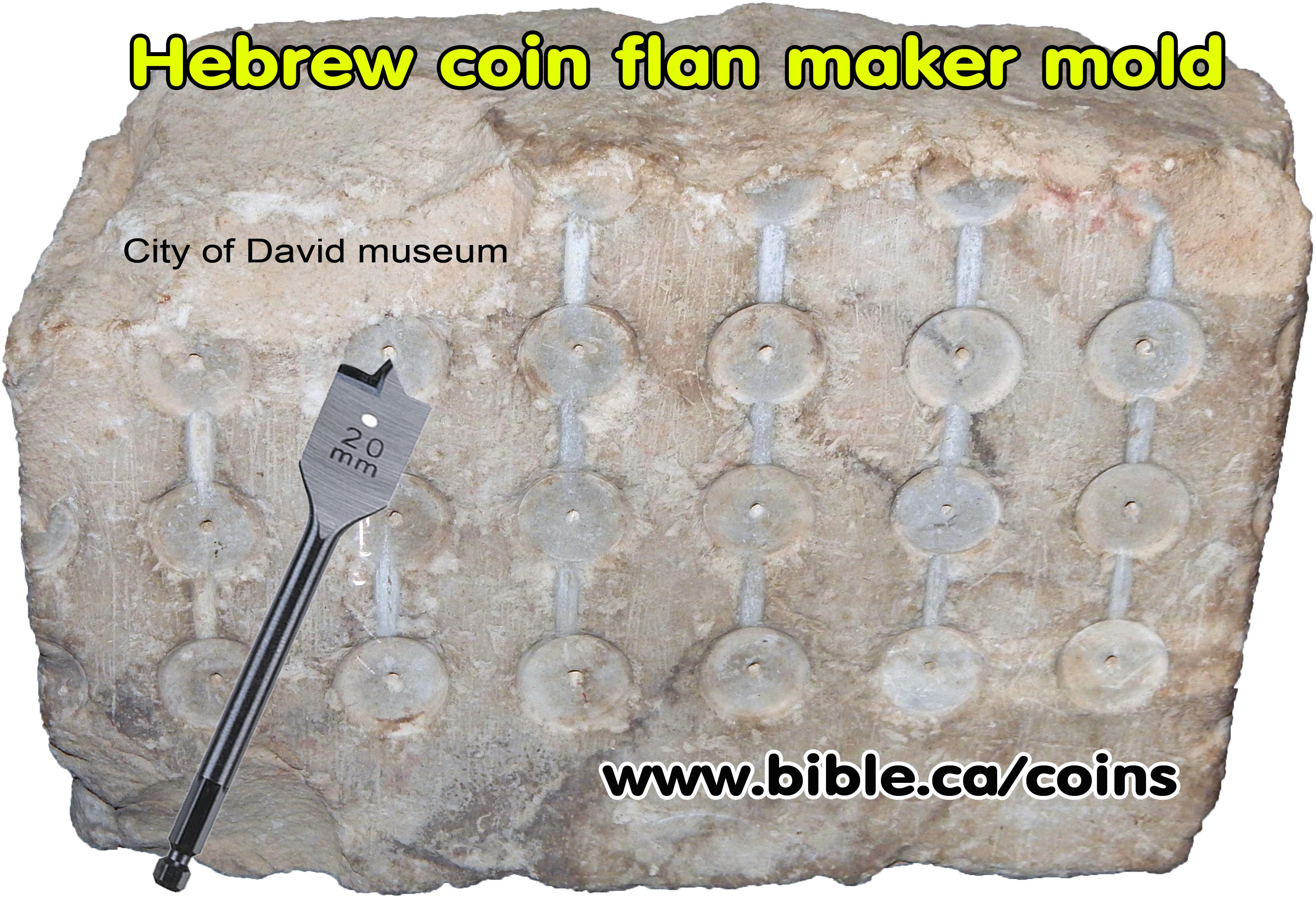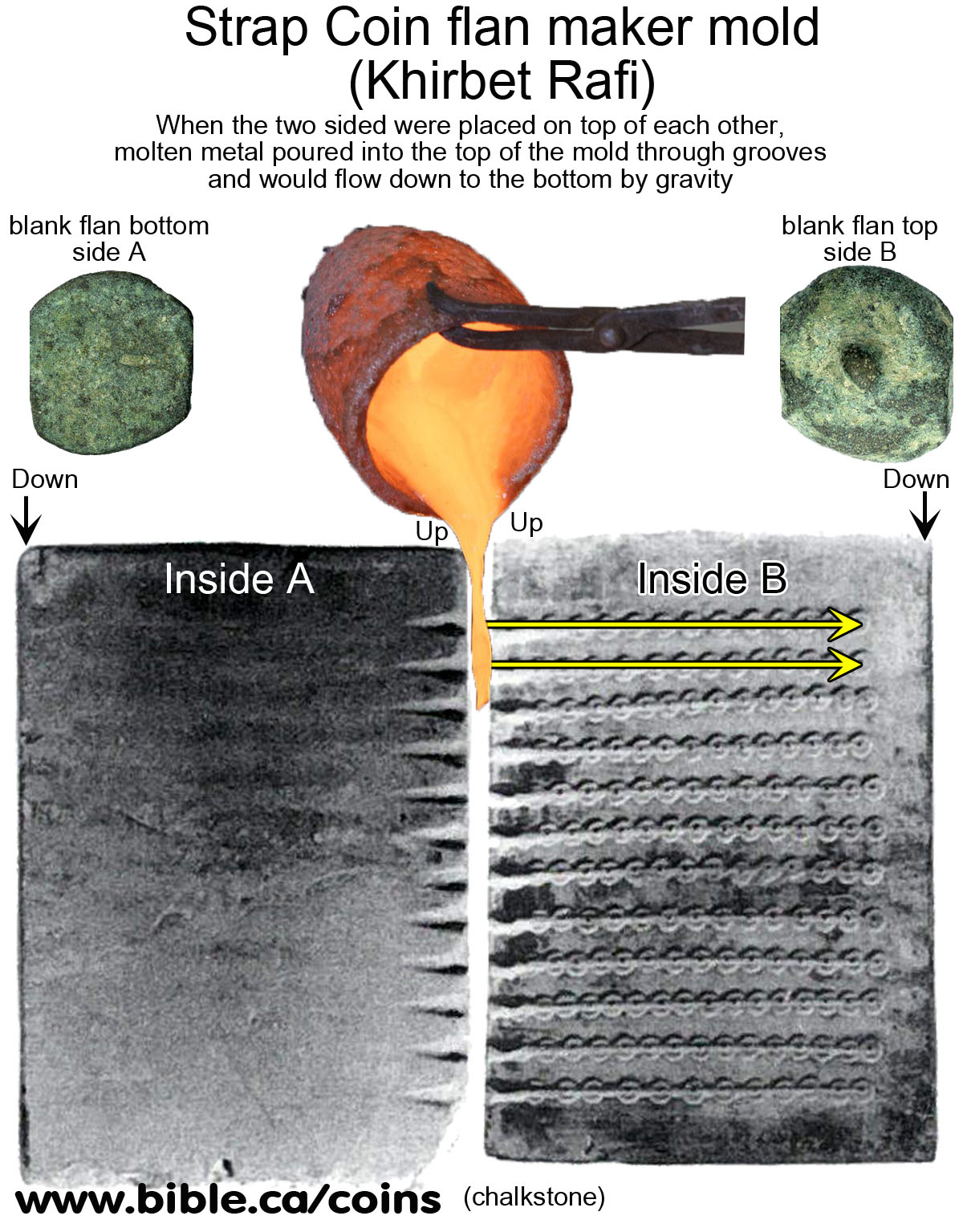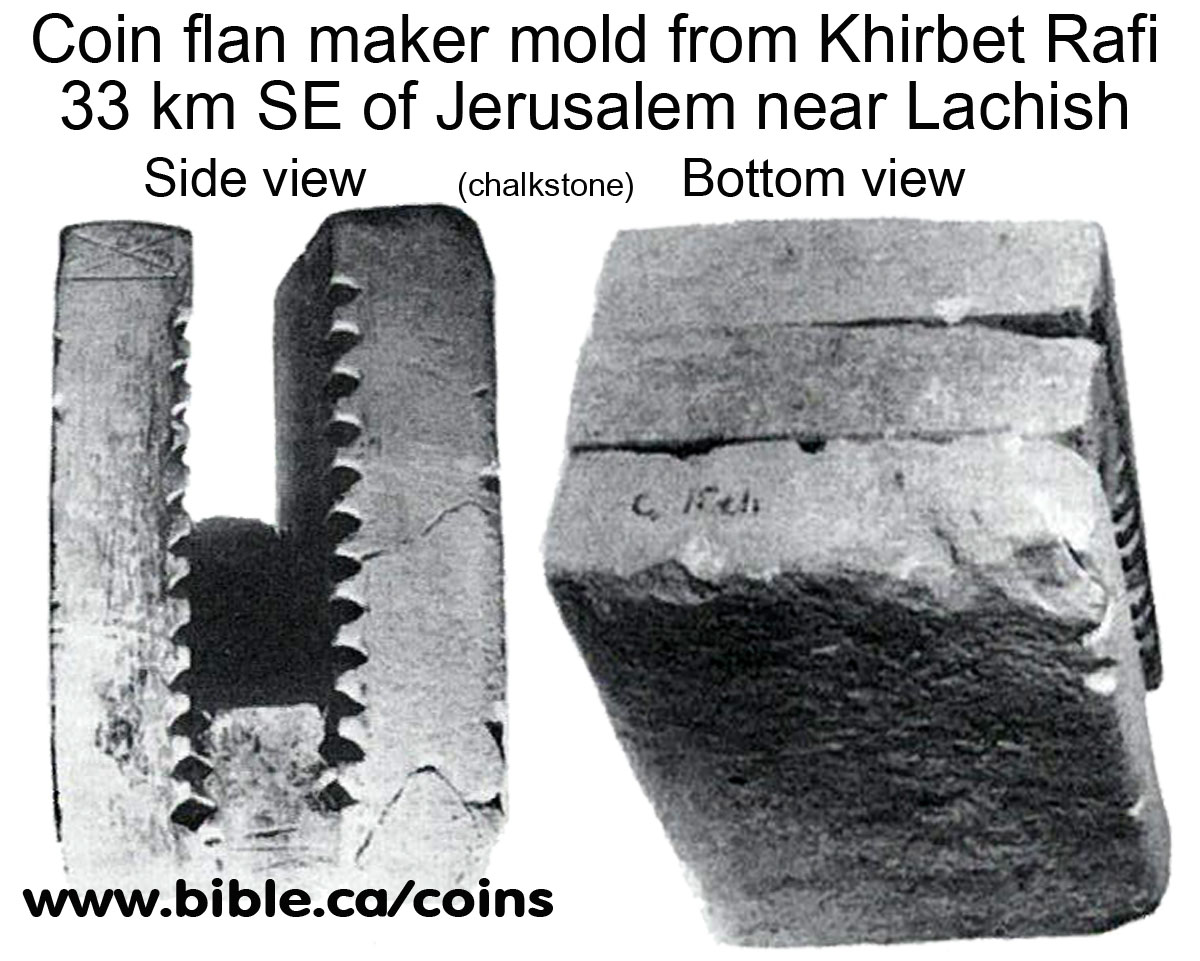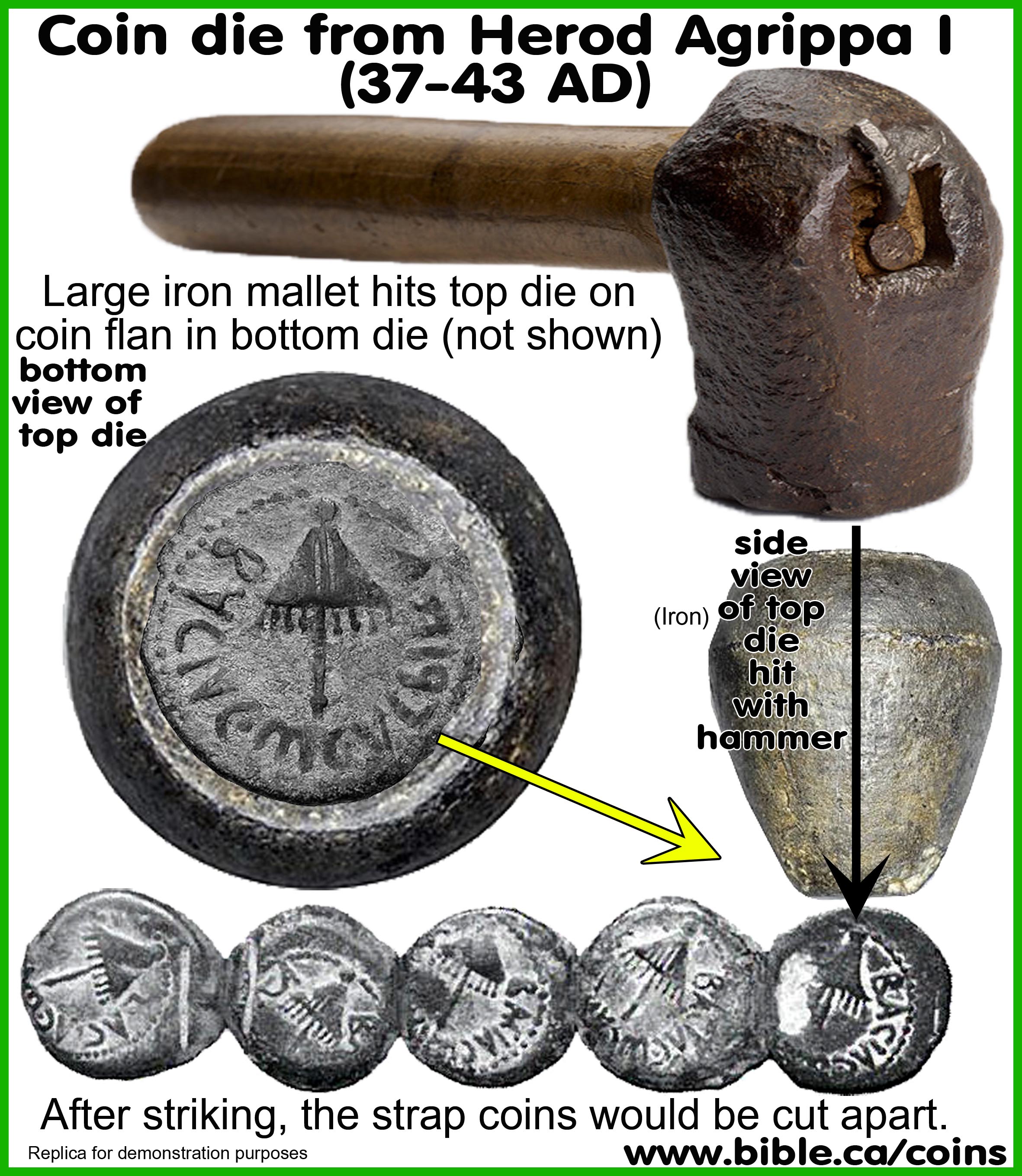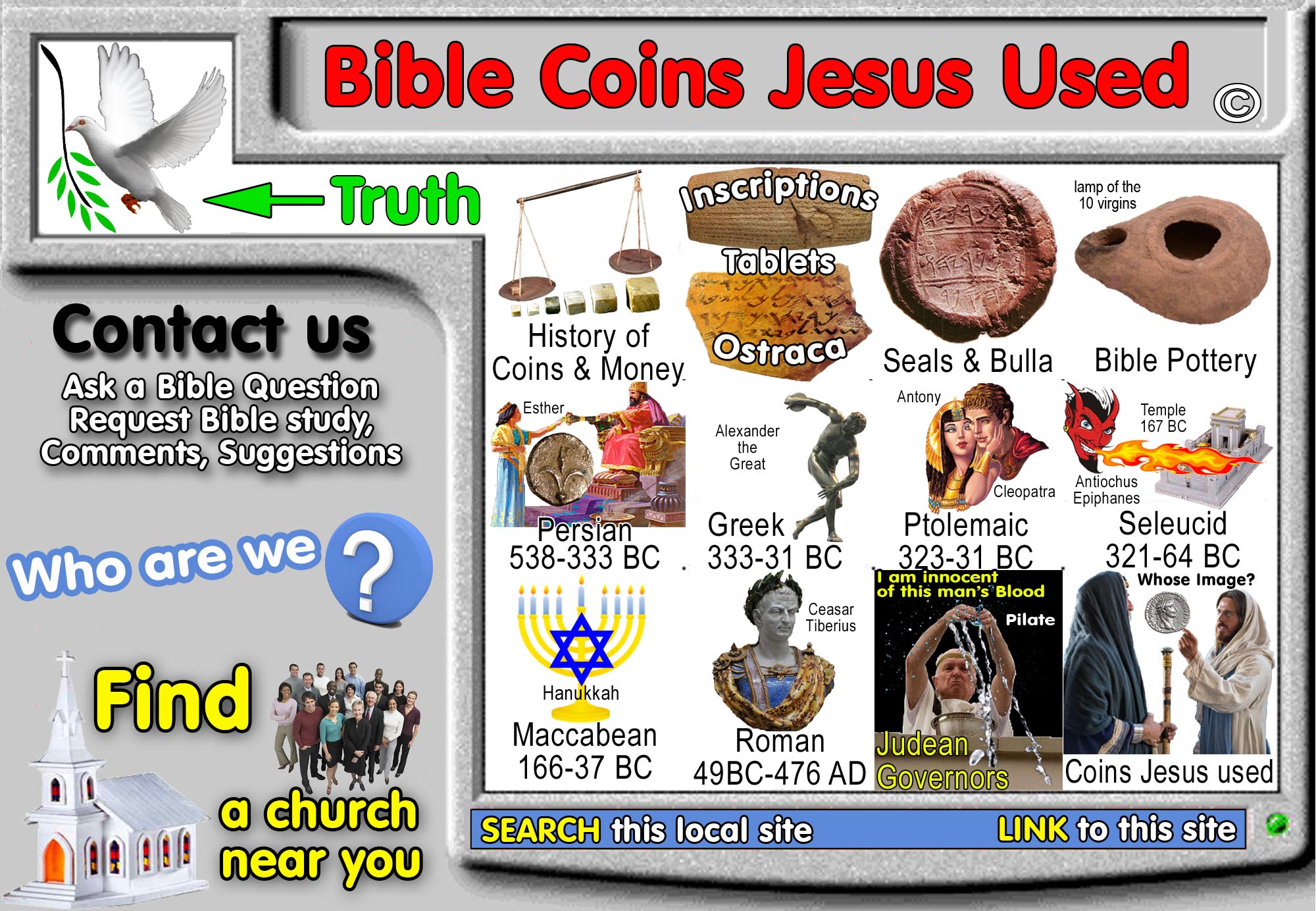History of Bible coins and the Hebrew money weight system
"Can I justify wicked scales and a bag of deceptive weights?" (Micah 6:11)
Coins of the Bible
|
Coins of Jesus and the Bible · History of Money and the weight system · Hebrew units of Money · How money was made · Where money was made
"Can I justify wicked scales and |
Introduction
- Chronology of Biblical coins: In order to understand coins used in Israel, it is helpful to become familiar with the statue vision of Daniel 2 because we have organized this presentation to correspond with these four kingdoms.
- Babylon Empire: 626-539 BC (no coins were made)
- Persia Empire: 539-333 BC
- Greek/Hellenistic Empire: 333-31 BC
- Ptolemy ruled Egypt: 323-30 BC
- Seleucus (Seleucid) ruled Syria, Persia, Babylon, parts of Asia minor: 321-64 BC
- Hasmonean era ruled by Jewish Maccabean family as recorded in the Apocrypha: 166-37BC.
- Rome controlled Judea at the time of Jesus and destroyed Jerusalem in 70 AD: 30 BC - 476 AD
- We live with coins and paper money but before about 600 BC, coins did not exist. Instead, a weight standard existed similar to the Gold Standard the world used up to the 20th century.
- Most weigh stones during the Iron age (1100-587 BC) were smooth polish dome-shaped limestone with flat bottoms.
- "Until 1998, only 211 of the inscribed Judaean weights had been found in archaeological excavations; more than half came from Jerusalem and its surroundings (76), Lachish (25), and Arad (15)." Many non-inscribed weights have also been discovered and some of them show markings in ink or paint. Thus it is possible that most of the uninscribed Judaean limestone weights were once labeled by this method, both less expensive and less permanent than engraving upon the stone." (Hendin, p74)
- Here is a 2 shekel weigh stone:
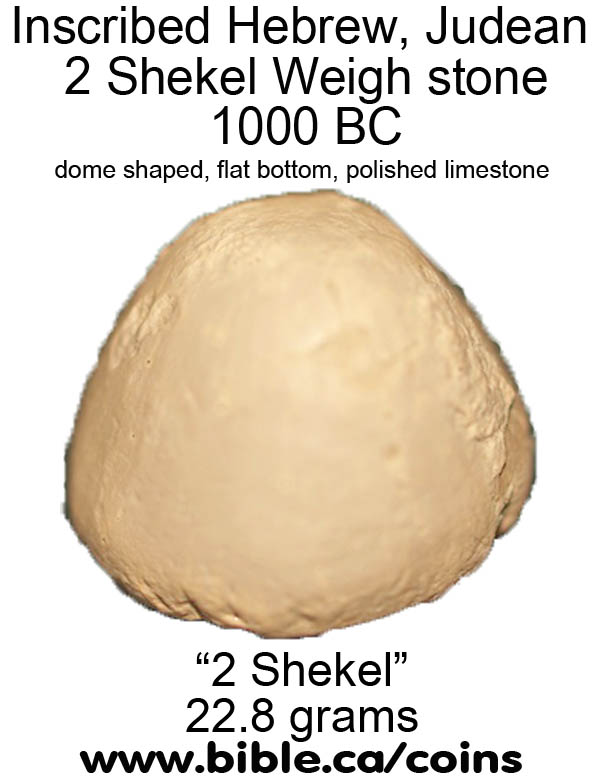
- A set of 5 rare inscribed Hebrew, Judean weigh stones:
- 8 Shekels (91.2grams)
- 1 Shekel (11.4 grams)
- 1 Nezef (9.12 grams)
- 1 Pym (7.6 grams)
- 1 Beqa (5.7 grams)
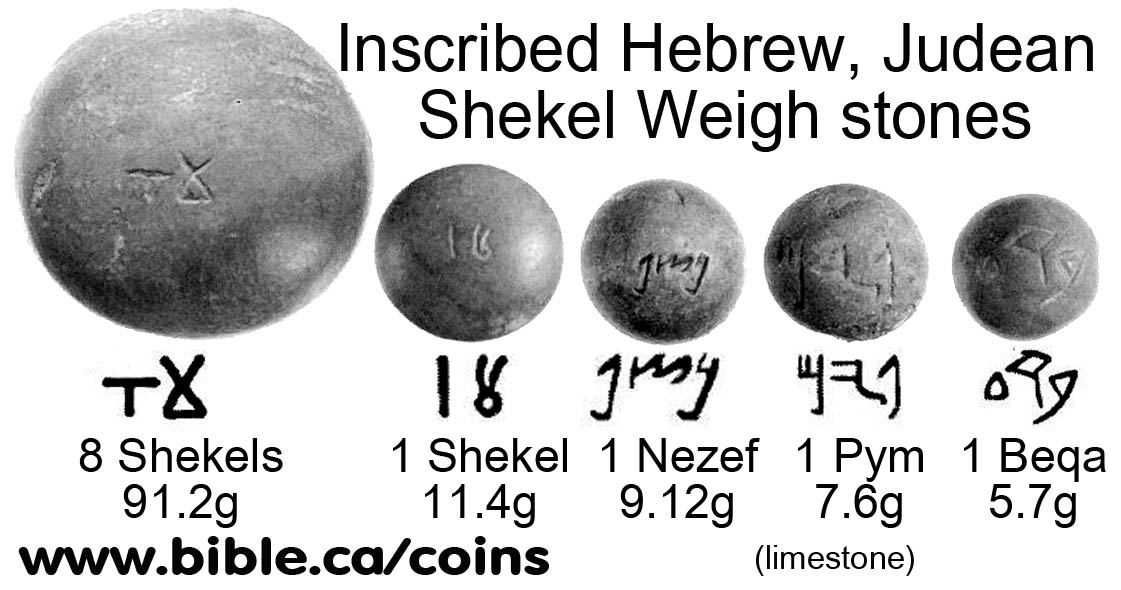
- Eight Hebrew weight stones from 701 BC excavated in Lachish, stratum II: four stones were 8 shekels and the other four stones were 4 shekels along with 17 bullae including the famous Shebna bulla of Isa 22:15-19.
- Although coins were first used in Babylon and Athens at early at the 6th century BC, the first coins were used in Israel about 378 BC.
- Jesus identified the three metals used for coins as money: "Take no gold, or silver, or copper (bronze) in your belts" (Matthew 10:9)
- Since coins were produced by kings and rulers, the coins often had their image on them: "And He said to them, “Whose likeness and inscription is this?” They said to Him, “Caesar’s.” Then He said to them, “Then render to Caesar the things that are Caesar’s; and to God the things that are God’s.”" (Matthew 22:20-21)
- However, Jewish coins would use sunbursts or other symbols in place of the image of the ruler as seen in the 2 Prutot of Alexander Jannaeus the widow put into the treasury at the temple.
- Coins were made by pouring molten metal into "flan molds".
- When cool, each blank flan would be punched in a set of metal dies that had the image on the obverse (front, heads) and reverse (back, tails) sides of the coin.
- Some coins were poured in "straps" and would have be cut apart from each other before use.
- Counterfeit coins did exist but unlike today, they were accepted and circulated as long as they were believed to be gold, silver or bronze AND had a specific weight equal to the official coin. Just like the gold rush days, the value was tied to the weight of the metal, not some government assurance through an official mint.
- Currencies other than metals include livestock, land. Human slaves were valued at 20-30 shekels of silver.
- Livestock and land had an equivalent value to metals: "And Joseph answered, “Give me your livestock, and I will give you food in exchange for your livestock, if your money is gone.” So they brought their livestock to Joseph; and Joseph gave them food in exchange for the horses, the flocks, the herds, and the donkeys. That year he supplied them with food in exchange for all their livestock. When that year was ended, they came to him the following year, and said to him, “We can not hide from my lord that our money is all spent; and the herds of cattle are my lord’s. There is nothing left in the sight of my lord but our bodies and our lands. Shall we die before your eyes, both we and our land? Buy us and our land in exchange for food. We with our land will become slaves to Pharaoh; just give us seed, so that we may live and not die, and that the land may not become desolate.”" (Genesis 47:16–19)
- “If the ox gores a male or female slave, the owner shall give his or her master thirty shekels of silver, and the ox shall be stoned." (Exodus 21:32)
- Joseph was sold for 20 pieces of silver: "Then some Midianite traders passed by, so they pulled him up and lifted Joseph out of the pit, and sold him to the Ishmaelites for twenty shekels of silver. Thus they brought Joseph into Egypt." (Genesis 37:28)
- God hated dishonest scales, weights:
- "Can I justify wicked scales And a bag of deceptive weights?" (Micah 6:11)
- "“You shall not have in your bag differing weights, a large and a small. “You shall not have in your house differing measures, a large and a small. “You shall have a full and just weight; you shall have a full and just measure, that your days may be prolonged in the land which the Lord your God gives you." (Deuteronomy 25:13–15)
- "A false balance is an abomination to the Lord, But a just weight is His delight." (Proverbs 11:1)
- "You shall do no wrong in judgment, in measurement of weight, or capacity. ‘You shall have just balances, just weights, a just ephah, and a just hin; I am the Lord your God, who brought you out from the land of Egypt." (Leviticus 19:35-36)
- “You shall have just balances, a just ephah and a just bath. “The ephah and the bath shall be the same quantity, so that the bath will contain a tenth of a homer and the ephah a tenth of a homer; their standard shall be according to the homer." (Ezekiel 45:10-11)
- “When will the new moon be over, So that we may sell grain, And the sabbath, that we may open the wheat market, To make the bushel smaller and the shekel bigger, And to cheat with dishonest scales, So as to buy the helpless for money And the needy for a pair of sandals, And that we may sell the refuse of the wheat?" (Amos 8:5-6)
- "If I have walked with falsehood, And my foot has hastened after deceit, Let Him weigh me with accurate scales, And let God know my integrity." (Job 31:5–6)
- "A merchant, in whose hands are false balances, He loves to oppress." (Hosea 12:7)
- "If a merchant gives grain or silver as an interest-bearing loan. and when he gives it as an interest bearing loan he gives the silver according to the small weight or the grain according to the small seah measure but when he receives payment he receives the silver according to the large weight or the grain according to the large seah-measure, [that merchant] shall forfeit [anything that he gave]." (Code of Hammurabi, Section 94, S ii 10′–21′, 1754 BC)
I. The history of the weight-money system:
|
Before coins (600 BC) everything was measured by weight or volume. Today 6 shekel coins in Israel will buy you a coffee. In ancient times 6 shekels was a specific weight and the value was dependent upon what was being weighed in the scale! Weight stones were a standard weight system place in one side of the balance. |
- The earliest money system was based upon specific price of the weight of metals and commodities.
- Today, we do not use the weight system: It is quite convenient to carry tiny coins and bills in your pocket equal to the "monetary value" of 200 kilograms of metal. However, governments have huge stockpiles of gold in places like Fort Knox in reserve that back up the otherwise worthless paper currency. On June 5, 1933, Franklin Roosevelt took the USA off of the "Gold Standard", where coins and paper money currency had to be backed by and equal value of gold in Fort Knox and other repositories.
- The Biblical currency and the money of the Bible was based entirely on the weight of gold, silver and bronze, Iron of Goliath's spear, ( 1 Samuel 17:7), myrrh and cinnamon (Exodus 30:23), Absalom's hair (2 Samuel 14:26)
- "Now Abram was very rich in livestock, in silver, and in gold." (Genesis 13:2)
- "Abraham agreed with Ephron; and Abraham weighed out for Ephron the silver that he had named in the hearing of the Hittites, four hundred shekels of silver, according to the weights current among the merchants." (Genesis 23:16)
- "Then I set apart twelve of the leading priests: Sherebiah, Hashabiah, and ten of their kin with them. And I weighed out to them the silver and the gold and the vessels, the offering for the house of our God that the king, his counselors, his lords, and all Israel there present had offered; I weighed out into their hand six hundred fifty talents of silver, and one hundred silver vessels worth … talents, and one hundred talents of gold, twenty gold bowls worth a thousand darics, and two vessels of fine polished bronze as precious as gold." (Ezra 8:24–27)
- "And I bought the field at Anathoth from my cousin Hanamel, and weighed out the money to him, seventeen shekels of silver." (Jeremiah 32:9)
- After leaving Kadesh Barnea Israel was commanded: "You shall purchase food from them [Edom/Moab] for money [lit: Silver], so that you may eat; and you shall also buy water from them for money, so that you may drink." (Deuteronomy 2:6)
- "with all the silver and gold which you find in the whole province of Babylon, along with the freewill offering of the people and of the priests, who offered willingly for the house of their God which is in Jerusalem; with this money [lit: silver], therefore, you shall diligently buy bulls, rams and lambs, with their grain offerings and their drink offerings and offer them on the altar of the house of your God which is in Jerusalem." (Ezra 7:16–17)
- A talent a shekel and was a specified weight of a precious metal which was understood to have a specific "monetary value".
- Before coins, Third/fourth of a shekel is not a coin but a fraction of a known and accepted weight of a shekel: 1 Sam 9:8; Ne 10:32. Remember that coins were not used in Israel until after 400 BC.
- Later, for convenience, a coin was struck with various symbols on it, to standardize the "value" of the corresponding weight of the gold, silver or bronze metal.
- Coins allowed a quick exchange of trusted value without the need for scales. This meant that coins could be traded quickly without the need to weigh each one because the "minted" weight could be trusted.
- The question is this: If Israel continued to use a money value tied directly to the weight of the gold, silver or bronze, why use coins? The answer is simple: coins were easy to identify as an accepted certified weight. You could trust the coins were all the same basic weight/value because the government had produced the coins.
- When many coins of the same metal were exchanged they were often weighed, as opposed to counted. This is why it didn't matter if coins of the same denominations were slightly different weights. Several different denominations of the same metal were thrown on a scale and weighed and the value was determined I spite of their "face value" from the mint.
- A sanctuary shekel was certified by the priests at the time of Moses. The Tyrian shekel was first minted when Tyre threw off the controls of the Seleucids in 125 BC. The Tyre shekel/sheqel followed the style of coin minted in 128 BC for Demetrius II Nicator Sotor. The bust of Demetrius on the obverse side was replaced by the bust of Hercules. On the reverse side the eagle standing on the prow of the boat remained basically unchanged. The shekel of Tyre was minted between 125 BC and 66 AD when the first Jewish war broke out. It was the standard coin (and the only coin) accepted in the Jewish temple at the time of Jesus. The story of Jesus telling Peter to pay the temple tax for the two of them featured a Tyrian shekel retrieved from the mouth of a fish. Judas was paid 30 Tyrian shekels to betray Jesus. Jesus overturned the tables of the money changers, whose job was to exchange standard coins for Tyrian shekels to pay the temple tax according to the law of Moses: Mt 17:27; 21:12; 26:15
- "When any of you commit a trespass and sin unintentionally in any of the holy things of the Lord, you shall bring, as your guilt offering to the Lord, a ram without blemish from the flock, convertible into silver by the sanctuary shekel; it is a guilt offering." (Leviticus 5:15)
- "you shall accept five shekels apiece, reckoning by the shekel of the sanctuary, a shekel of twenty gerahs." (Numbers 3:47)
- Weights of the Persian Empire and the origin of the Daric coin
- Darius the Mede (539-537 BC) created the Daric gold coin: "Some modern scholars favor the view that the Persian gold coin called the Δαρεικός (daric) by the Greeks takes its name from the Persian throne name “Darius.” This is based in part on the affirmation of this etymology by Herodotus, and in part on philological and archeological evidence. Darics are gold staters, and each of them also had the value of what the Athenians call the ‘gold coin’ (ὁ χρυσοῦς). But darics are not named, as most suppose, after Darius the father of Xerxes, but after a certain other more ancient king. Thus, Harpocration affirms that there was a king named “Darius” who preceded, at an unspecified distance in time, Darius Hystaspes. This comment is striking because of its source—a secular Greco-Roman researcher who did his research at the greatest library in antiquity." (Darius The Mede: A Reappraisal, Steven David Anderson, P155, 2014 AD)
- King Darius produced large stones (seen below) with his royal/official inscriptions on them to certify that the stone was the exact weight for a given measure. Several of these stones, each of a different official weight, are known to exist and several have been excavated through archeology and are in museums today.
- The basic unit of Darius' (521-486BC) weight system was the karšâ (83.30 gram). The karsa was the equivalent of 1/6 of a Babylonian mina. Darius then divided the karšâ into ten shekels of 8.33 grams each, which corresponded to the weight of a gold daric (dareikos) which is mentioned in the Bible during the Persian Empire.
- 1 karšâ = 83.30 grams = 10 Gold Darics
- 6 karšâ = 1 Babylonian Shekel
- Known Persian Weight Stones:
- 2 karsa = 166.60 grams
- 120 karsa =99,96 kg
- 60 karsa = 59.98 kg (pictured below)
“60 karšayâ. I am Darius, the great king, king of kings, king of all nations, king of this earth, the son of Hystaspes, the Achaemenid.” (inscription on 60 Karsa "DWd" diorite weight from the Treasury of Persepolis)
- Sumerian Duck Weights: 2070 BC
- Weight in shape of duck; inscription relates setting of this weight as 5 minas by of Ur (2094-48 B.C.) for the god Nanna of Ur 2070 BC
- A mina weighed about 0.6 kilograms, or 18 ounces, so this Duck Weight standard weighed 3 KG or about 6.5 lbs
- In the photo is a Hebrew coin struck around 320 BC, that
imitates the old stone duck weights by featuring a duck with its head
tucked behind its back.
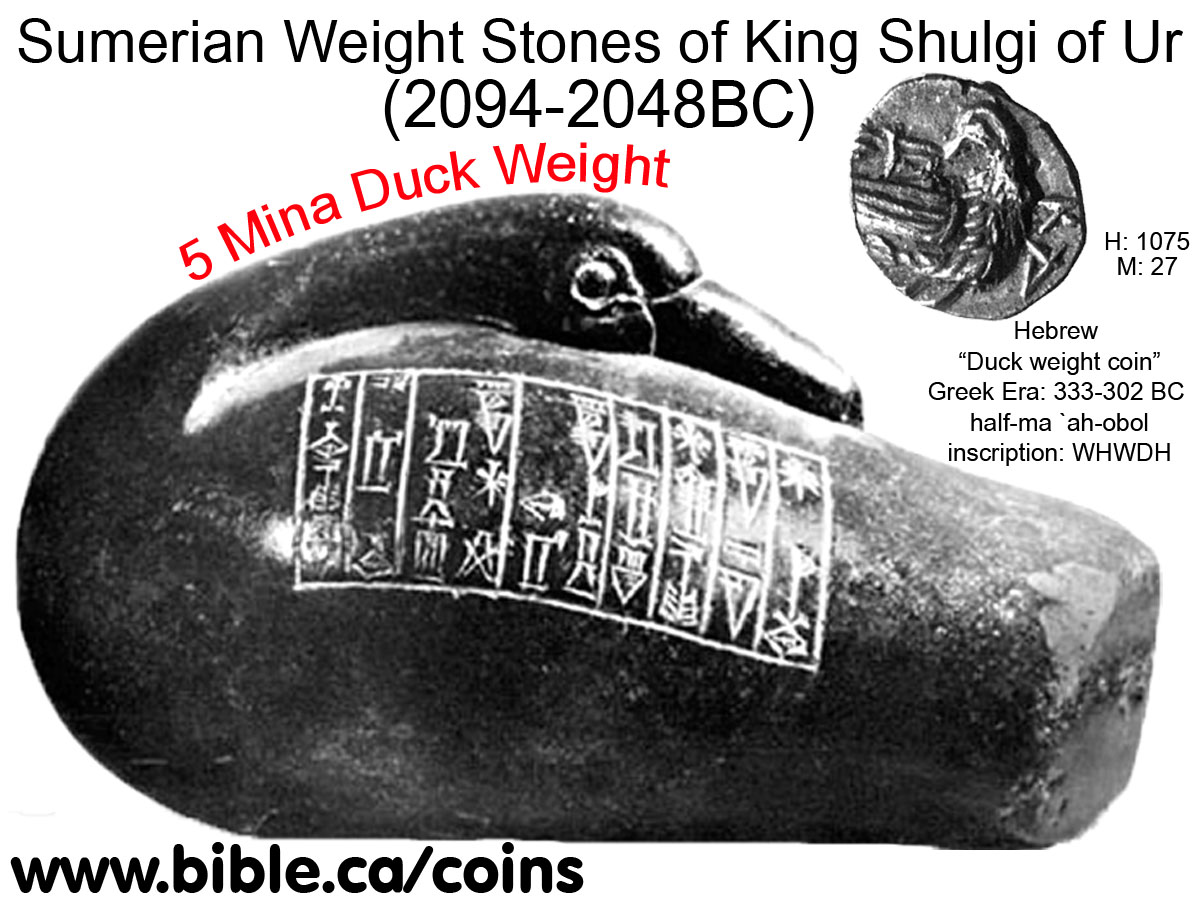
- Duck Head Jewish coin minted in the Hellenistic age (Greek 333-31 BC)
- "Why a duck on an early Jewish coin? There are no ducks or geese mentioned in the Old or New Testaments. On the other hand, stone or metal figures of ducks, geese, or swans, with head turned back, were commonly used as scale weights in the ancient Middle East. As I point out in Ancient Scale Weights, duck-shaped weights are found in Mesopotamia as well as Egypt and Syria/Palestine. Dates for the duck-shaped weights range from around the Middle Bronze Age (ending around 1550 BCE) to the Late Iron Age (mid-sixth century BCE) and may have extended into the Persian, Hellenistic, and Roman Periods.52 Thus early coins from the Near East could carry an image similar to the form of some local, Babylonian, and Egyptian scale weights." (Hendin, p120)
- This Hebrew “Duck weight coin” minted during the early Greek Era: 333-302 BC is a half-ma, `ah-obol.
- The inscription is "YHWDH" for the province of Judah (YHD)
- Notice the duck has its head tucked behind its back just like ducks
sleep and EXACTLY like the ancient Sumerian duck weight stones!
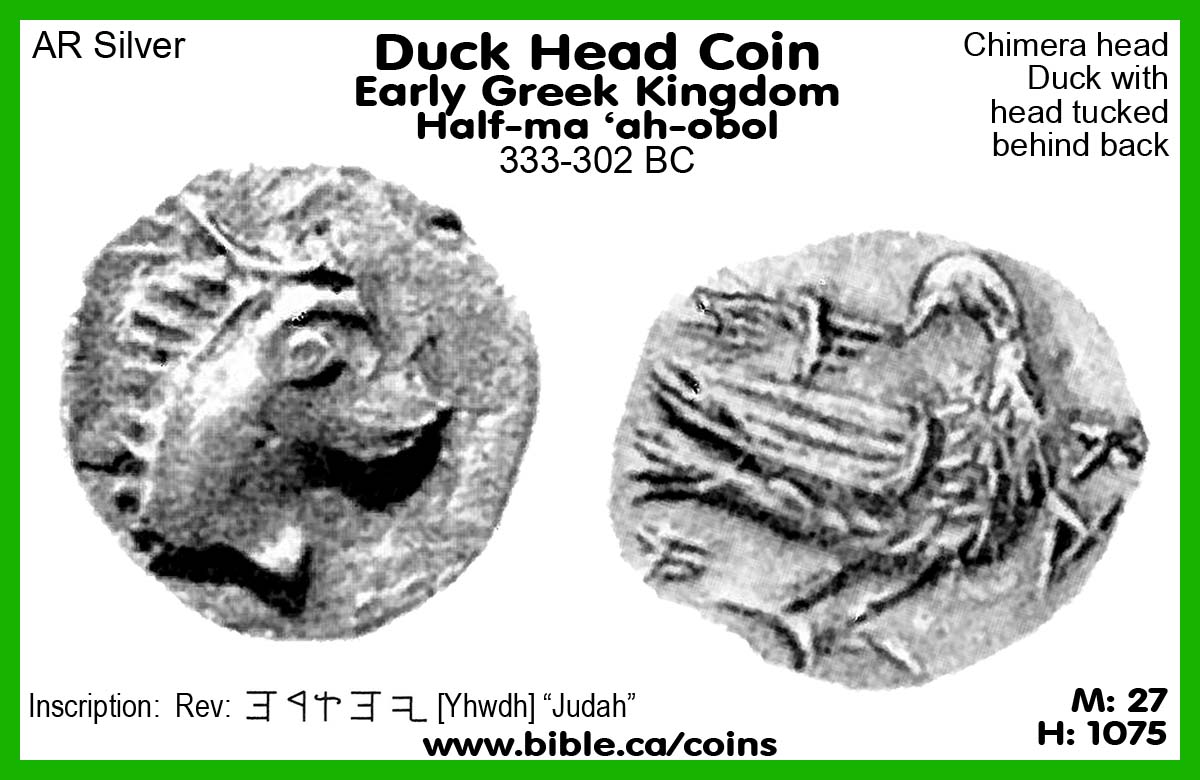
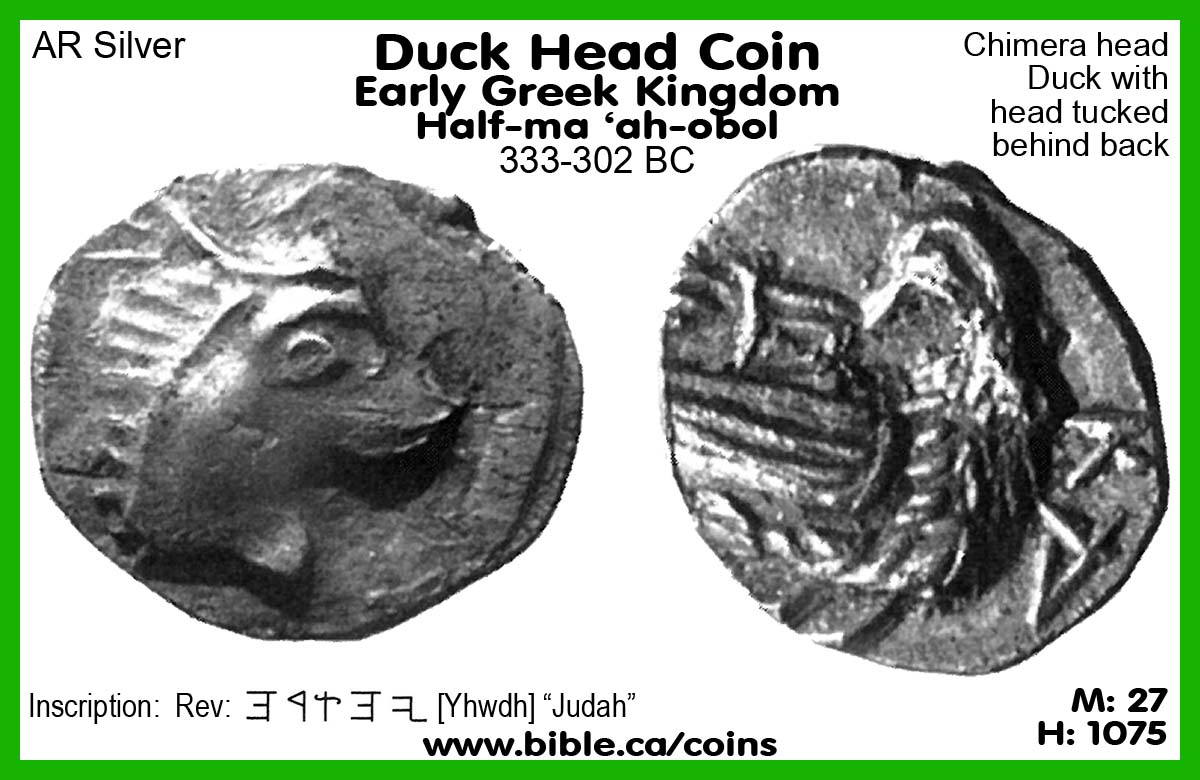
- Denominations of coins in the Ptolemaic empire (Egypt)
- There were hundreds of coins produced during the Ptolemaic era of many varieties.
- During the earliest years of the empire, Ptolemy II (282-246 BC) for example produced a series of coin denominations in gold, silver and bronze.
- The same sets of coins were manufactured in up to four different mint cities: Sidon, Ptolemais, "Gaza" Tyre and Alexandria.
- Below is the series of coins produced at the Gaza "Tyre" mint.
- Notice the sequence of eagle motifs that progress large
to small. This progression in size, weight and logical pictorial diagrams
of eagles made the money easy to use and remember their value.
Drachm: (72 grams, 42mm) Two Eagles standing wings closed.
Tetrobol: (48 grams, 36 mm) One Eagle standing wings open.
Diobol: (24 grams, 30mm) One Eagle standing wings closed.
Obol: (12 grams, 24mm) One Eagle standing wings open.
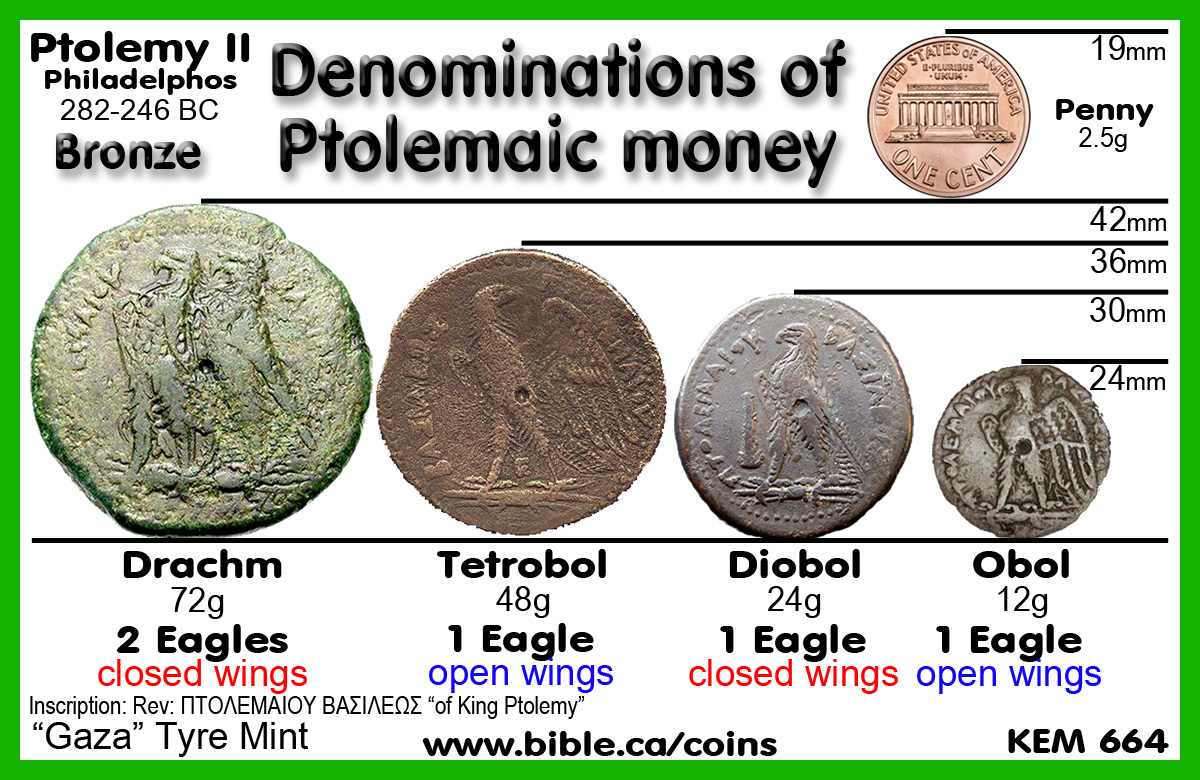
II. Denominations of biblical coins in the first century:
- We have created a valuation chart based on the value of coins at the time of Jesus, the apostles and the church.
- Throughout the history of Israel, there have been references to various weight standards: commercial standard, king's weight standard, temple of the sanctuary standard
- "Abraham listened to Ephron; and Abraham weighed out for Ephron the silver which he had named in the hearing of the sons of Heth, four hundred shekels of silver, commercial standard." (Genesis 23:16)
- "When he cut the hair of his head (and it was at the end of every year that he cut it, for it was heavy on him so he cut it), he weighed the hair of his head at 200 shekels by the king’s weight." (2 Samuel 14:26)
- "“This is what everyone who is numbered shall give: half a shekel according to the shekel of the sanctuary (the shekel is twenty gerahs), half a shekel as a contribution to the Lord." (Exodus 30:13)
- Pounds, Pennies, Farthings, Mites are British units of money that did not exist in the first century. They represent an honest effort by the translators of the KJV to create a relative idea for the reader of the value under discussion.
- The British pound in Luke 19:13 is actually ten mina equal to 10 x 100 days wages or 1000 days wages total. "“And he called ten of his slaves, and gave them ten minas and said to them, ‘Do business with this until I come back.’" (Luke 19:13)
- The British penny in Mt 20:2 is actually a denarius equal to a 1 day’s wages. “When he had agreed with the laborers for a denarius [KJV: penny] for the day, he sent them into his vineyard." (Matthew 20:2)
- The British penny in Mk 6:37 is actually 200 denarus equal to a 200 x 1 days wages = 200 days wager total. "But He answered them, “You give them something to eat!” And they said to Him, “Shall we go and spend two hundred denarii [KJV: pennyworth] on bread and give them something to eat?” (Mark 6:37)
- The British farthing in Mt 5:26 is actually a quadran worth two lepta (what the widow put in the treasury) equal to 1/64th of a day’s wages. “Truly I say to you, you will not come out of there until you have paid up the last quadran [NASB: cent; KJV farthing]." (Matthew 5:26)
- The British mite in Lk 12:59 is actually a lepta, the smallest coin equal to a half-prutah, which is equal to 1/128th of a days wages. "I say to you, you will not get out of there until you have paid the very last lepta [NASB: cent; KJV: Mite]." (Luke 12:59)
- The British mite in Luke 21:2 is actually a lepta equal to 128th of a days wages. "And He saw a poor widow putting in two lepta [NASB: small copper coins; KJV: Mites]." (Luke 21:2)
- We cannot be certain about the value of each coin or each coins value in relation to each other.
- It is important remember that there was considerable variation in the weight of shekels and minas from 2000 BC - 70 AD. This would mean that there are different conversion rates between the various denominations of coins or corresponding weights.
- Coins have had different values in each of the Persian, Hasmonean and Roman period. There have been noted devaluations of coins in both the Hasmonean time (75-40 BC and 50 AD)
- Neither the Bible, nor Josephus give us the names of the Jewish bronze coins that were used at the time of Jesus.
- Coins were valued by weight and the inscriptions on each but the weights varied for coins of the same value.
- The valuation of the prutah, lepton and half-prutah as specific denominations cannot be established by their weights alone, given the variations for all three.
- Archeological excavations at Khirbet el Maqatir in Israel (Ai of Joshua, Ephraim of Jesus) located 15 km north of Jerusalem have uncovered a first century city and hundreds of coins dating from 300 BC - 70 AD. This scientific information gives us a very good look at the coins Jesus used every day.
- Bible information on various coin values:
- This passage shows us that one talent = 3000 Shekels: "The silver of those of the congregation who were numbered was 100 talents and 1,775 shekels, according to the shekel of the sanctuary; a beka a head (that is, half a shekel according to the shekel of the sanctuary), for each one who passed over to those who were numbered, from twenty years old and upward, for 603,550 men." (Exodus 38:25-26)
- "The amount of money the widow threw into the Temple treasury was two coins of the smallest size in existence in Jerusalem at that time. There is no doubt that the small prutah (Nos. 1152, 1153) or half-prutah (Nos. 1134, 1138, 1147, 1185-87) coins of the Hasmonean kings and Herod the Great, fit that description. The most common coin among them, easily by a factor of more than 1000 to 1, is the small prutah of Jannaeus and possibly his successors." (Guide to Biblical Coins, David Hendin, 5th edition, p475, 2010 AD)
- The weight equivalent of the talent may have originated:
- Its weight varied over time and nation: For example an Ashdod talent: 22 to 22.5 kg., an Ugaritic talent: 28 to 29.5 kg, Others: 34-39 kg
- It is believed the origin of the talent was the weight of a load a man can carry.
- Some have speculated that a talent was equal to the weight of water to an amphora jug: 1 cu foot weighs 28.3 kg
Chart: Coins of the Bible, Jesus, the gospels, the apostles, the church, the Roman world
|
Talent (Kikar) |
28,500 Lepton (widow’s mite) 1200 Denarii 3000 Shekels 60 Minas 1 Kikar |
34.2 kg |
|
2 Kings 23:33 |
|
Mina |
60 mina = 1 talent A standard weight stone. |
570g |
||
|
8 shekel |
8 Judean shekels = 1 Egyptian/Ugaritic deben (10 qedet) = 12 Phoenicia-Ashdod- Mesopotamian shekels |
91.2g |
|
|
|
4 shekel |
4 Judean shekels = 1/2 Egyptian/Ugaritic deben = 6 Phoenicia-Ashdod- Mesopotamian shekels |
45.6g |
|
|
|
Shekel |
1 Tyrian shekel = 1 Tetradrachm 3000 shekels = 1 talent 50 shekels = 1 mina Head Tax = ˝ shekel (5.7g) |
11.40g |
Joshua 7:21; 2 Sam 14:26; Ex 30:13; Mt 17:27; 21:12; 26:15 |
|
|
Nezef |
3750 nezef = 1 talent 62.5 nezef = 1 mina 5/6 nezef = 1 shekel |
9.12g |
|
|
|
Pym 2/3 shekel) |
4500 Pym = 1 talent 74 Pym = 1 mina 2/3 Pym = 1 shekel 1 Judean Pym = 1 Phoenicia-Ashdod- Mesopotamian shekel |
7.60g |
|
1 Sam 13:21 |
|
Bekah, Beqa (half-shekel) |
1 Bekah = half-shekel Tyrian 6000 Bekah = 1 talent 100 Bekah = 1 mina 2 Bekah = 1 shekel |
5.7g |
|
Ex 30:13-15; 38:26 |
|
1/3 shekel |
Nehemiah's temple tax |
|
|
Neh 10:33 |
|
Rebah Ľ shekel |
Saul's give to Samuel |
|
|
1 Sam 9:8 |
|
Gerah (20) |
60,000 Gerah/20= 1 talent 1000 Gerah/20 = 1 mina 20 Gerah/20 = 1 shekel |
.57g |
|
Numbers 3:47 |
|
Gerah (24) |
71,250 Gerah/24= 1 talent 1187.5 Gerah/24 = 1 mina 24 Gerah/24 = 1 shekel |
.48g |
|
|
|
Bath |
10 bath = 1 homer |
Wet Volume of 22 liters of water |
|
|
|
Ephah |
10 ephah = 1 homer |
Dry volume of 22 liters of water |
|
|
|
Homer |
1 homer = 10 baths/ephahs |
Dry volume 220 liters of water |
|
|
|
Denarius (Plural Denarii) |
1 = 1 day’s wages Roman era 1 = 1 Drachma 1 denarius = 64 quadrans 4 denarii = 1 shekel |
|
Roman |
Mt 20:2 Equal to a days wages |
|
As (Plural asses) |
4 Quadrans = 1 As 16 Asses is a Denarius |
|
Roman |
Luke 21:1-4 |
|
Quadran (Plural quadrans)
|
1 prutah = 1 Quadran 2 lepta = 1 Quadran 4 Quadrans = 1 As 64 quadrans = 1 denarius/drachma 256 quadrans = 1 shekel |
|
Roman |
Luke 21:1-4 |
|
Prutah (Plural Prutot) |
1 prutah = 1 Quadran 2 lepta = 1 prutah 64 prutot = 1 denarius/drachma 256 prutot = 1 shekel |
|
Greek, Ptolemaic |
|
|
Half-prutah (plural half-prutot) |
1 half-prutah = 1 letpa 2 half-prutah - prutah 128 half-prutah = 1 drachma/denarius |
|
Greek, Ptolemaic |
|
|
Dekadrachm |
10 drachmae |
43 grams |
Greek, Ptolemaic |
|
|
Tetradrachm |
1 tetradrachm = 1 Tyrian shekel 4 tetradrachm = 1 drachma 2 tetradrachm = 1 mina |
17.2 grams |
Greek, Ptolemaic |
|
|
Didrachm |
2 drachmae = half-shekel Tyrian |
8.6 grams |
Greek, Ptolemaic |
|
|
Drachma (Plural drachmas) |
4 drachma = 1 Tyrian shekel 6000 drachmas = 1 talent 1 denarius = 1 drachma 192 prutot = 1 denarius 6 obols 336 leptons |
4.3 grams |
Greek, Ptolemaic |
|
|
Tetrobol |
4 obols |
2.85 grams |
Greek, Ptolemaic |
|
|
Triobol |
3 obols |
2.15 grams |
Greek, Ptolemaic |
|
|
Diobol |
2 obols |
1.43 grams |
Greek, Ptolemaic |
|
|
Obol (Plural Obols) |
6 obols = 1 drachma 24 Obols = 1 tetradrachm 4 tetartemoria |
0.72 grams |
Greek, Ptolemaic |
|
|
Half-obol (plural Half-obols) |
12 Half-obols = 1 drachma 2 half-obols = 1 Obol |
.36 grams |
Greek, Ptolemaic |
|
|
Lepta (Plural Lepton) |
1 letpa = 1 half-prutah 2 lepton = 1 quadran/prutah 7 lepton = 1 cholkos 128 lepton = 1 drachma/denarius |
.12 grams |
Greek, Ptolemaic |
Widow gave two lepta (2 Prutot of Alexander Jannaeus) |
|
Quarter-obol |
24 quarter-obols = 1 drachma 4 quarter-obols = 1 Obol |
.18 grams |
Greek,Ptolemaic |
|
|
Tritartemorion |
3 tetartemoria |
0.54 grams |
Greek, Ptolemaic |
|
|
Hemiobol |
2 tetartemoria |
0.36 grams |
Greek, Ptolemaic |
|
|
Trihemitetartemorion |
3/2 tetartemorion |
0.27 grams |
Greek, Ptolemaic |
|
|
Tetartemorion |
4 Tetartemorion = 1 obol |
0.18 grams |
Greek, Ptolemaic |
|
|
Hemitetartemorion |
2 Hemitetartemorion = 1 tetartemorion |
0.09 grams |
Greek, Ptolemaic |
|
|
Chalkoi (plural chalkos) |
8 chalkos = 1 obol 48 chalkos = 1 drachma |
.9 grams |
Seluecid |
General word for money Mark 12:41 |
|
AA/Octuple |
25-33 mm. |
20.0-27.99 gm. |
Seleucid |
|
|
A/Triple, quadruple |
22-28 mm. |
11.0-16.99 gm. |
Seleucid |
|
|
B/Double |
17-22 mm. |
5.49-8.49 gm. |
Seleucid |
|
|
C/Unit |
15-21 mm. |
3.0-5.49 gm. |
Seleucid |
|
|
D/Half |
12-14 mm. |
1.49-2.99 gm. |
Seleucid |
|
|
E/Quarter |
8-11 mm. |
0.6-1.00 gm. |
Seleucid |
|
III. Cities where Bible coins were made?
- Map of Coin Mints and where the coins of the bible were made:
- "Early in his career, Israeli numismatic scholar Ya'akov Meshorer made a random surface find in Jerusalem of an archaic Attic tetradrachm. Along with other late sixth and fifth century BCE silver coins of Athens, Acanthus, Aegina, Cannus, Chios, Corinth, Cyprus, Cyzicus, Kindya, Kos, Lampsacus, Lycia, Miletos, Paphos, Phocaea, Samos, Sinope, Stagira, and Thasos, these are the earliest coins found in Israel." (Guide to Biblical Coins, David Hendin, 5th edition, p67, 2010 AD)
- "Not a single ancient mint has yet been absolutely identified in ancient Judaea, Samaria, or the Galilee. However, flan molds for coins of Mattatayah Antigonus have been found in excavations in the Old City of Jerusalem. Similar molds for prutah and half-prutah size coins have also been found at locations as diverse as Khirbet Rafi` near Lachish and Sepphoris in the Galilee. The mints in Judaea and the surrounding areas must have been relatively small, and there were probably only a few die engravers working on the same coin types. … When one discusses an ancient mint, it is easy to visualize a version of a modern mint—a production factory located within a single building or structure. That might have been the case, especially in sophisticated classical Greek mints such as Athens. However, characteristics and style of production in smaller mints such as Judaea lead to a possibly different concept, especially for the Judaean bronze coins. In the case of the Jewish War and the Bar Kokhba Revolt, there were almost certainly second mints, one possibly moving with troops, or manned by those hiding out in the Judaean Hills." (Guide to Biblical Coins, David Hendin, 5th edition, p39, 2010 AD)
|
Israeli coin mints |
Other Mints from 525 BC |
|
1. Acco 2. Antioch Syria 3. Arwad, Arados, Phoenicia 4. Ashdod 5. Ashkelon 6. Caesarea 7. Cypress 8. Dora (Dor) 9. Gamla 10. Gaza 11. Gerasa 12. Hippos 13. Jerusalem 14. Joppa 15. Khirbet Rafi (33 km SE of Jerusalem near Lachish) 16. Mt. Gerizim? 17. Nysa-Scythopolis (Beit She'an) 18. Paneas 19. Samaria (Sebaste) 20. Sidon 21. Tiberias 22. Tyre 23. Zippori (Sepphoris) |
1. Acanthus 2. Aegina 3. Alexandria 4. Athens 5. Cannus 6. Chios 7. Corinth 8. Cyprus 9. Cyzicus 10. Kindya 11. Kos 12. Lampsacus 13. Lugdumum 14. Lycia 15. Miletos 16. Paphos 17. Phocaea 18. Rome 19. Samos 20. Sinope 21. Stagira 22. Thasos |
IV. How coins were made: The manufacture of coins:
|
Hebrew, Judean Coin
Molds |
- Coins were made from gold, silver and bronze.
- The metals would be heated until molten and then poured into molds to create blank coin flans.
- The two sides of the mold would be put together.
- Notice the grooves at the top of each half of the mold.
- Molten metal is poured in these grooves on the top and the metal would flow by gravity to the bottom.
- This is a strap coin mold maker from Khirbet Rafi.
- Once the metal cooled they removed the strips of coin flans.
- Flan blank dimples:
A rotary tool very much like today's modern flat wood drill bit, was used
to drill out the mold so that the coins could be created. The result was
little dimples on the flan blanks.
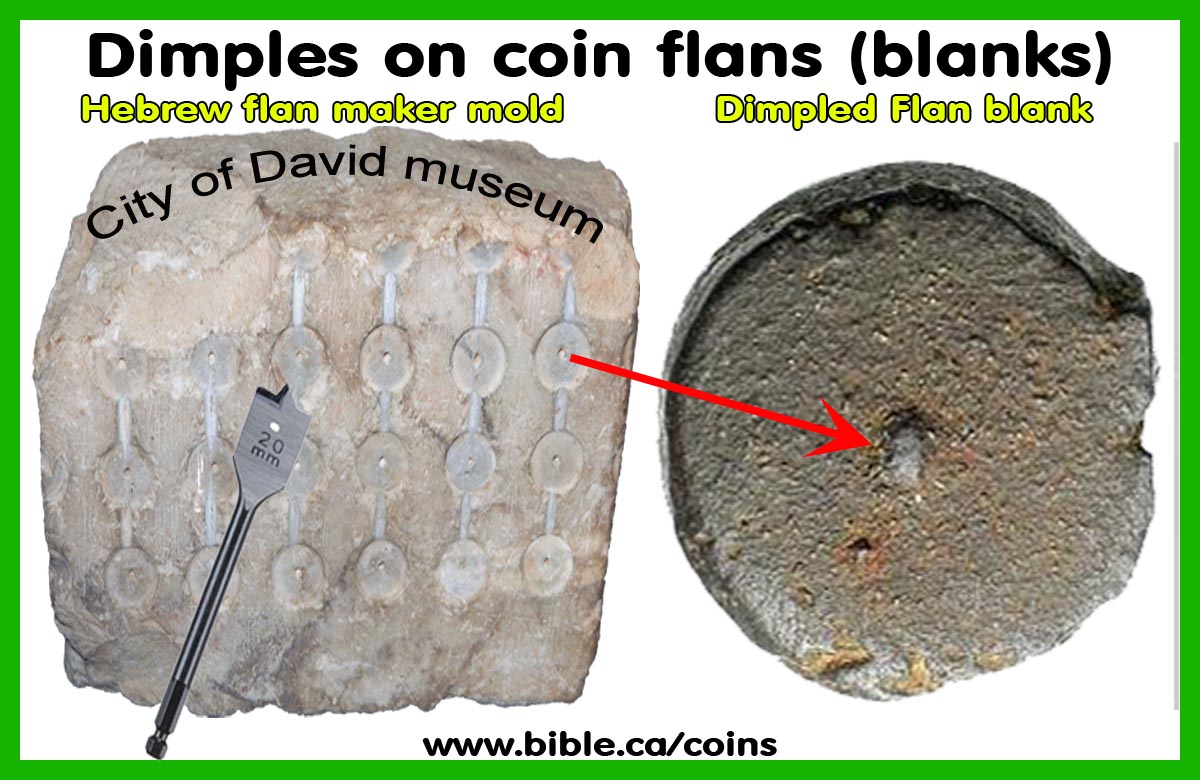
- Center punch mark holes:
Coins were sometimes planed with a rotary tool that looks much like a flat
wood bit. It was used to smooth one or both sides of the flan to remove
dross, little ridges and give the flan a bit of a polish. The result was a
little hole in the coin where the center tang of the polishing drill
anchored itself into the coin. Contrary to first appearance, these
"center punch marks" are not made by center punching the coin
after they were in circulation. This center hole was on the blank flan
before it was hammered in the dies. These holes are common in Seleucid
coins, do not detract from their value and are not considered defects.
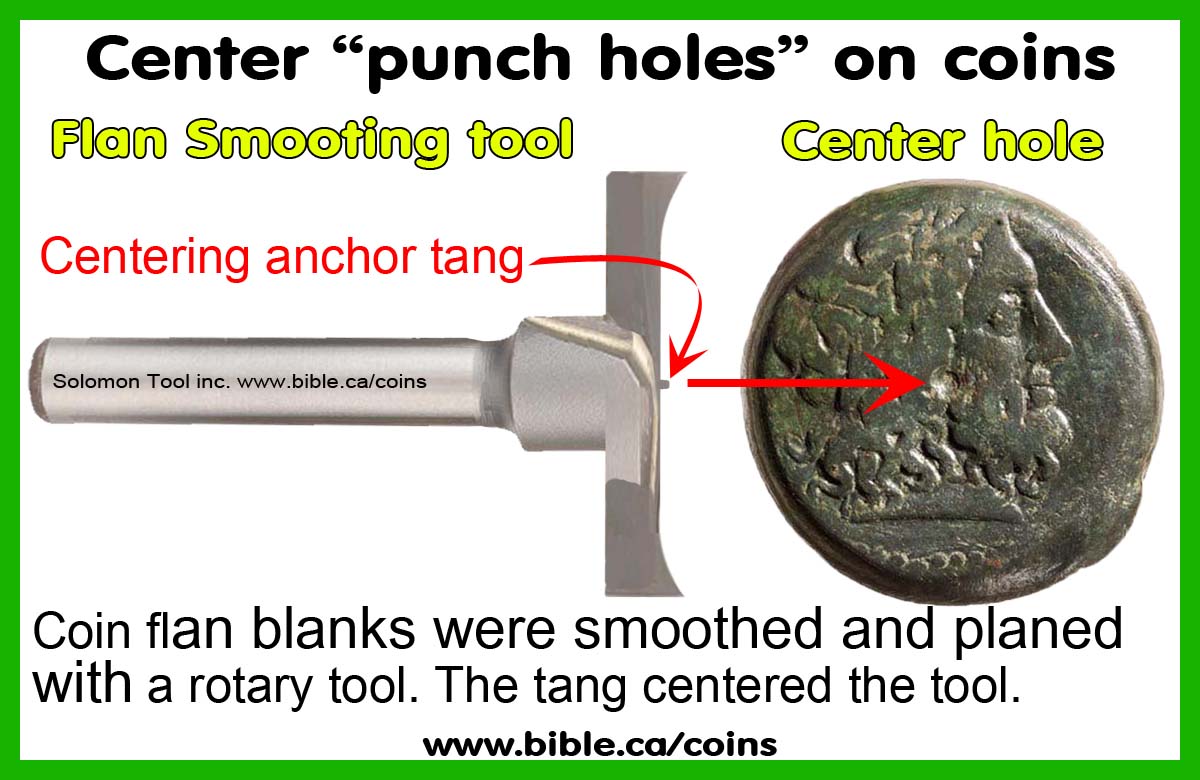
- There were a set of two dies made from iron and the blank coin flan would be placed in the bottom die, which was on a large stable rock.
- They would place the top die on and strike it with a large iron mallet.
- The coins would then be cut apart and trimmed of excess metal.
Conclusion:
- The basic concept of coins and paper money being equivalent to a specific value of precious metal is 4000 years old.
- In economics, it is important to be able to trade one good for another, or for a universally accepted standard of value.
- 1 cow = 5 sheep, etc.
- 1 cow = specified weight of precious metal.
- 1 cow = x number of coins
- Coins as money did not exist before about 500 BC. Judean coins were first made about 400 BC.
- During the first century, Jesus used coins that were Roman, Tyre (Phoenician), Roman authorize "Hebrew" and Hasmonean.
- The Roman coins would be of the Caesars like Tiberius.
- The Tyre, Phoenician coins would be for the temple taxes.
- The Roman authorized "Hebrew" coins Jesus used were the Governors of Judea, appointed by Rome like Herod I, Marcus Ambibulous, Valarius Gratus, Pilate, Agrippa I, Agrippa II and Festus.
- The Hasmonean coins Jesus used were the only coins minted when Judea was independent: John Hycranus I, Aristobulous I, Alexander Janeus, Hycranus II, Aristobulous II and the last of the Maccabeans, Antigonus.
- Now that you have a good understanding of the history of money and how coins were made, let's explore the coins used in different periods of Bible history.
By Steve Rudd: Contact the author for comments, input or corrections.
